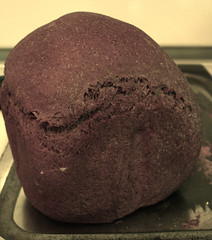Baking Day
I am the proud owner of a Zojirushi Mini bread machine.

When I’m not impulsively buying bread at farmers markets, I try to bake my own. Although I read a lot of commentary from serious bakers that bread machines are great for kneading and rising, but that they always take the dough out and shape it in the oven, I always just press the Start button and come back in 3 hours and 40 minutes to a nice, square loaf. I don’t know whether it’s Zo’s superior technology, or that bread machine engineering has improved in general since the 1990’s, but the first bread machine I owned had a silly cylindrical pan and a paddle that would always come off in the loaf, and have to be sliced free.
My standard recipe has quite a few ingredients, but I’m always happy with how it comes out.
Now, why do I use all of these things? Eggs always make bread rise higher for me. I have borderline high cholesterol, and so I use sunflower oil instead of butter. I use fat at all because I like the addition to the texture. I like the taste of honey, and it’s a local sweetener (though god knows I use plenty of cane sugar in other things.) When I have lots of apples, I use one in each loaf instead. I add the oats before the other dry ingredients so that they’ll have more of a chance to absorb liquid. The gluten is there to help the rise, since I use 100% whole grains in my baking. The milk powder makes a slightly more tender crumb, and the potato flour absorbs moisture and helps keep the bread from drying out.
The mixed whole grain flour I make by combining oat, spelt, millet and brown rice flours in a big container. I find amaranth, buckwheat, corn and (especially) rye to be too strongly flavored for this blend, although I’ll use them for bread that I want to have that particular flavor. Except amaranth. I think it tastes too grassy, even if it is the mystic grain of the Aztecs.
I only ever use King Arthur Flour’s organic white whole wheat flour. Trader Joe’s has now come out with their own brand of white whole wheat flour, and, if they ever get an organic source, then I would be happy to try it. (That is, I use only this flour for baking bread. For scones, cakes, cookies, &c., I use Arrowhead Mills whole wheat pastry flour.) I find the taste of white wheat flour (which is white because it lacks the phenolic acid-containing pigment that makes normal wheat red) to be much milder. I honestly used to hate whole wheat (although whole wheat pastries in the 80’s were more like dwarf bread from the Discworld than anything else.)
Today, however, I baked something different. I am having people over to help me eat strawberries and greens, but I also have a lot of radishes, and I decided I wanted to serve them with black bread and butter. So here’s what I baked today.
Why did I leave the dry milk and the potato flour out? I don’t know. No good reason; if I went and made another loaf after writing this post, I’d probably put them in. It came out very nice, I think.

